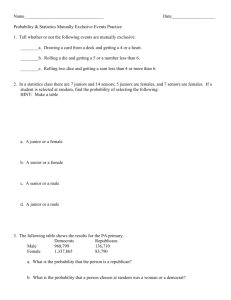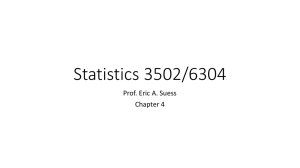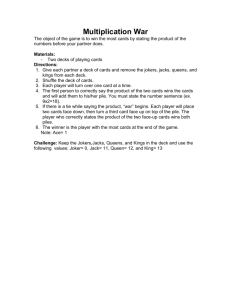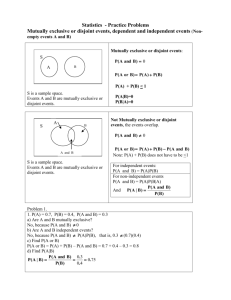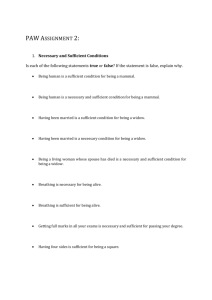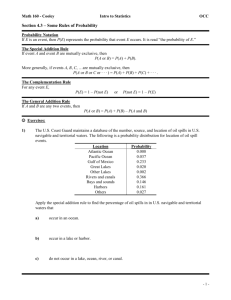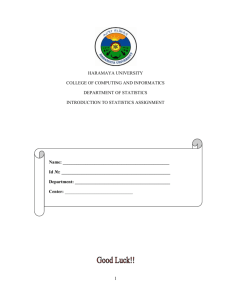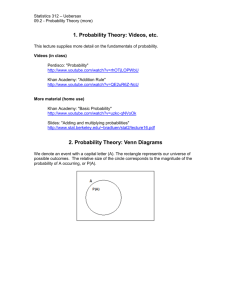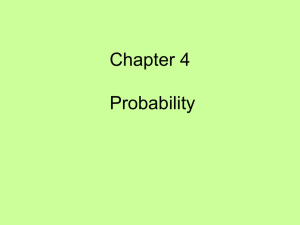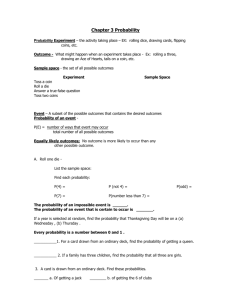Elementary Statistics - V55.0105
advertisement
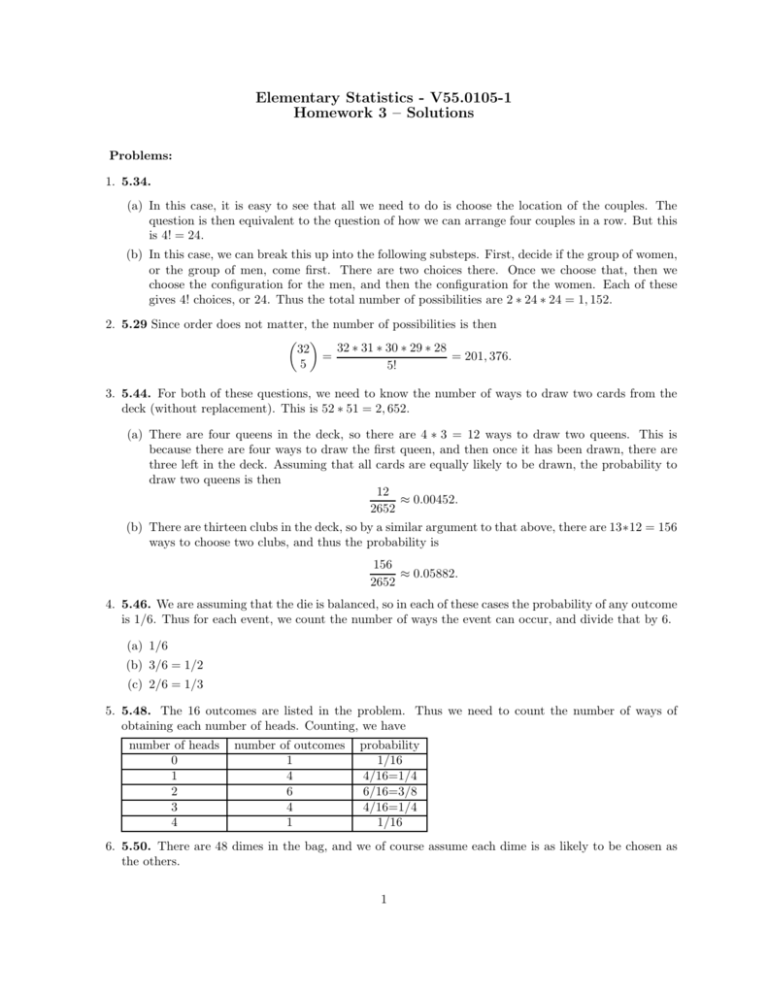
Elementary Statistics - V55.0105-1
Homework 3 – Solutions
Problems:
1. 5.34.
(a) In this case, it is easy to see that all we need to do is choose the location of the couples. The
question is then equivalent to the question of how we can arrange four couples in a row. But this
is 4! = 24.
(b) In this case, we can break this up into the following substeps. First, decide if the group of women,
or the group of men, come first. There are two choices there. Once we choose that, then we
choose the configuration for the men, and then the configuration for the women. Each of these
gives 4! choices, or 24. Thus the total number of possibilities are 2 ∗ 24 ∗ 24 = 1, 152.
2. 5.29 Since order does not matter, the number of possibilities is then
32 ∗ 31 ∗ 30 ∗ 29 ∗ 28
32
=
= 201, 376.
5
5!
3. 5.44. For both of these questions, we need to know the number of ways to draw two cards from the
deck (without replacement). This is 52 ∗ 51 = 2, 652.
(a) There are four queens in the deck, so there are 4 ∗ 3 = 12 ways to draw two queens. This is
because there are four ways to draw the first queen, and then once it has been drawn, there are
three left in the deck. Assuming that all cards are equally likely to be drawn, the probability to
draw two queens is then
12
≈ 0.00452.
2652
(b) There are thirteen clubs in the deck, so by a similar argument to that above, there are 13∗12 = 156
ways to choose two clubs, and thus the probability is
156
≈ 0.05882.
2652
4. 5.46. We are assuming that the die is balanced, so in each of these cases the probability of any outcome
is 1/6. Thus for each event, we count the number of ways the event can occur, and divide that by 6.
(a) 1/6
(b) 3/6 = 1/2
(c) 2/6 = 1/3
5. 5.48. The 16 outcomes are listed in the problem. Thus we need to count the number of ways of
obtaining each number of heads. Counting, we have
number of heads
0
1
2
3
4
number of outcomes
1
4
6
4
1
probability
1/16
4/16=1/4
6/16=3/8
4/16=1/4
1/16
6. 5.50. There are 48 dimes in the bag, and we of course assume each dime is as likely to be chosen as
the others.
1
(a) There are 10 dimes dated 2002, so the probability of choosing one of these is
5
10
=
≈ 0.20833.
48
24
(b) There are 24 dimes with dates of 1999 and 2002, so the probability is
24
1
= .
48
2
7. 6.2. No. U ∩ V = {e, h} which is not empty.
8. 6.8.
(a) The picture should look exactly like that of Figure 6.1 on page 126.
(b)
K = {(0, 2), (1, 2), (0, 3)}
L = {(1, 0), (2, 0), (3, 0), (2, 1)}
M = {(0, 3), (1, 2), (2, 1), (3, 0)}.
(c) K and L are mutually exclusive, no other pair is.
9. 6.12.
(a) No, one could be speeding through the red light.
(b) No, technically one can be “foreign-born”, i.e. born outside of the United States, and yet still
be elected President. The Constitution requires that one be a “natural-born citizen”, i.e. eligible
for citizenship at the time of one’s birth, although this can occur in a foreign country. (But, of
course, what the book’s author intended was that these be mutually exclusive.)
(c) Yes, one cannot get a walk and a home run at the same at-bat.
(d) No, a player can (and many do) get a home run in one at-bat, and get walked at a different at-bat
in the same game.
10. 6.16. Let us define A as the set of accounting students and B the set of business law students. We
want to find the size of the set A ∩ B. What we know is that A has 77 students and B has 92 students.
Now, A ∪ B is the set of students enrolled in one or both of those classes. We know the size of (A ∪ B) 0 ,
the set of students enrolled in neither class, to be 92, and thus A ∪ B has 108 students. This means
that A ∩ B = 77 + 92 − 108 = 61. (If you don’t see why this is so, draw the Venn diagram for the
problem.)
11. 6.26.
(a) This violates Rule 3, since the events are mutually exclusive their probability must add to 1.
(b) The intersection of two mutually exclusive events is empty, and thus its probability is zero.
(c) A probability cannot be greater than one, because then its complement would have negative
probability, so this violates Rule 1.
(d) Same as part (b).
12. 6.32.
(a) 1 − 0.64 = 0.36
(b) 0.64 + 0.21 = 0.85
2
(c) 1 − 0.85 = 0.15
13. 6.40.
(a) 0.26 + 0.20 = 0.46
(b) 0.19 + 0.25 = 0.44
(c) 0.26 + 0.25 + 0.07 = 0.58
14. 6.42.
(a) 6/36 + 2/36 = 8/36 = 2/9
(b) 1/36 + 2/36 + 1/36 = 4/36 = 1/9
(c) 2/36 + 4/36 + 6/36 + 4/36 + 2/36 = 18/36 = 1/2
15. 6.50.
(a) Let A be the event that the coach is fired, and B the event that the GM is fired. Then we have
p(A) = 0.85, p(B) = 0.49, p(A ∩ B) = 0.27. But notice that p(A ∪ B) must be, at most, one. Thus
we have
1 ≥ p(A ∪ B) = p(A) + p(B) − p(A ∩ B) = 0.85 + 0.49 − 0.27 = 1.07.
This is a contradiction!
(b) Here we let A be the event the patient has high temperature, and B the event that the patient has
high blood pressure. Then, according to the problem, we have p(B) = .29 and p(A ∩ B) = 0.45
But this is not possible, since the set A ∩ B is contained inside the set B and thus cannot have a
larger probability! We must have p(A ∩ B) ≤ p(B).
3
